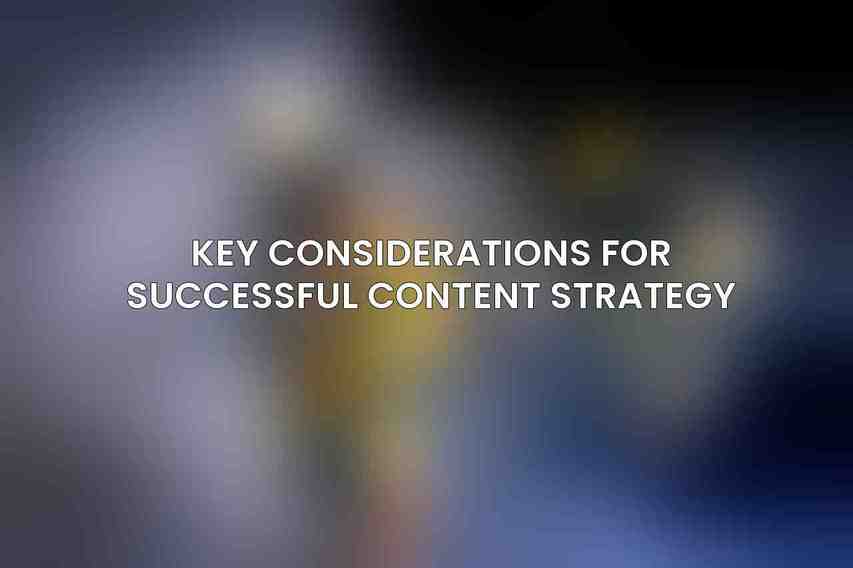content strategy plays a pivotal role in shaping successful marketing campaigns. Content strategy involves planning, creating, and distributing valuable content to attract and retain a targeted audience. It serves as the roadmap that guides all content creation efforts, ensuring alignment with business goals and audience needs.
A. Definition and Importance of Content Strategy
Content strategy is the art of planning, creating, and distributing valuable content to attract and retain a targeted audience. It involves identifying the audience’s needs and interests and developing a strategic approach to deliver content that resonates with them. A well-defined content strategy ensures that content creation efforts are purposeful, consistent, and aligned with the overall marketing goals of the business.
B. Benefits of a Well-Defined Content Strategy
A well-defined content strategy brings a myriad of benefits to a marketing campaign. Some of the key benefits include:- Improved brand awareness and visibility: By consistently delivering valuable content, businesses can increase their brand’s visibility and recognition among their target audience.- Enhanced audience engagement: Tailored content that addresses the needs and interests of the audience fosters engagement and loyalty.- Increased website traffic and lead generation: Strategic content creation can drive traffic to the website and convert visitors into leads or customers.
Target Audience Research
Understanding the target audience is crucial for the success of any marketing campaign. By conducting thorough research and analysis, marketers can gain valuable insights into the demographics, psychographics, needs, and interests of their target audience.
A. Identifying Audience Demographics and Psychographics
Demographics refer to quantifiable characteristics of the audience, such as age, gender, location, income, etc. Psychographics, on the other hand, delve into the audience’s interests, attitudes, behaviors, and values. By combining both demographics and psychographics, marketers can create detailed audience personas that guide content creation efforts.
B. Conducting Market Research and Analysis
Market research involves gathering and analyzing data about the market, competitors, and industry trends. Through market research, marketers can identify opportunities, threats, and gaps in the market that can inform their content strategy decisions.
C. Understanding Audience Needs and Interests
By understanding the needs, pain points, and interests of the target audience, marketers can create content that addresses these specific aspects. This targeted approach ensures that the content resonates with the audience and provides value, ultimately leading to higher engagement and conversions.
Channel Selection

Choosing the right channels to distribute content is crucial for reaching and engaging the target audience effectively. Different channels offer unique opportunities for content distribution, and selecting the most appropriate ones is key to a successful content strategy.
A. Identifying Relevant Content Distribution Channels
Marketers must identify the channels where their target audience is most active and receptive to content. These can include social media platforms, email newsletters, blogs, online forums, and more.
B. Evaluating Channel Reach, Engagement, and Cost
Each channel has its own reach, engagement levels, and associated costs. Marketers should assess these factors to determine which channels align best with their goals and budget.
C. Optimizing Content for Different Channels
Optimizing content for different channels involves tailoring the content format, tone, and style to suit the preferences of each specific platform. Adapting content for various channels enhances its visibility and engagement among the target audience.
Content Type Determination
Deciding on the types of content to create is a critical aspect of content strategy. Different content formats cater to diverse audience preferences and serve various purposes in the marketing funnel.
A. Types of Content: Blog Posts, Videos, Infographics, etc.
Content can take various forms, including blog posts, videos, infographics, podcasts, whitepapers, case studies, and more. Each type of content serves a unique purpose and caters to different audience preferences.
B. Mapping Content Types to Audience Needs
Marketers should align content types with the needs, preferences, and behaviors of their target audience. Understanding how each content type resonates with the audience helps in creating relevant and engaging content.
C. Creating a Content Calendar
A content calendar helps in organizing and planning content creation and distribution efforts. By scheduling content in advance, marketers can ensure consistency, variety, and timely delivery of content to engage the audience effectively.
Content Creation and Optimization
Crafting high-quality, engaging content is essential for capturing the audience’s attention and driving desired actions. Optimizing content for search engines and social media enhances visibility and ensures maximum reach.
A. Crafting High-Quality, Engaging Content
High-quality content is informative, valuable, well-written, and engaging. By focusing on delivering content that meets the audience’s needs and interests, marketers can establish credibility and build trust with their audience.
B. Using Keywords and SEO Best Practices
Integrating relevant keywords and following SEO best practices enhances the discoverability of content on search engines. Optimizing content with targeted keywords improves its ranking and visibility, driving organic traffic to the website.
C. Optimizing Content for Social Media Sharing
Crafting shareable content for social media platforms involves creating visually appealing, engaging, and interactive content that encourages users to like, comment, and share. Social media optimization increases content exposure and virality among a broader audience.
Content Promotion and Distribution
Promoting and distributing content across various channels is essential for maximizing its reach and engagement. Leveraging social media, email marketing, influencer partnerships, and guest blogging can amplify the visibility of content and drive traffic to the website.
A. Promoting Content on Social Media Platforms
Social media platforms offer a vast reach and engagement opportunities for promoting content. By sharing content strategically on platforms like Facebook, Twitter, LinkedIn, and Instagram, marketers can reach a larger audience and drive interaction.
B. Using Email Marketing for Content Distribution
Email marketing is a powerful tool for distributing content directly to the target audience’s inbox. By segmenting email lists, crafting personalized content, and nurturing leads through email campaigns, marketers can drive traffic and conversions effectively.
C. Exploring Influencer Marketing and Guest Blogging
Collaborating with influencers and industry experts can extend the reach of content to a wider audience. Guest blogging on reputable websites and partnering with influencers who share the target audience can enhance credibility, visibility, and engagement.
Content Analytics and Measurement
Tracking and analyzing content performance metrics provide valuable insights into the effectiveness of the content strategy. By interpreting data and metrics, marketers can optimize their strategies, improve content quality, and enhance audience engagement.
A. Tracking Content Performance Metrics
Key content performance metrics include website traffic, engagement rates, click-through rates, conversions, bounce rates, and social shares. Monitoring these metrics helps marketers understand how the audience interacts with the content and where improvements are needed.
B. Analyzing Data to Understand Audience Engagement
Analyzing data reveals valuable insights into audience behaviors, preferences, and responses to content. By understanding what resonates with the audience, marketers can tailor future content to meet their needs and drive better engagement.
C. Improving Content Strategy Based on Results
Based on data analysis, marketers can make informed decisions to optimize their content strategy. Adjusting content types, distribution channels, messaging, and timing based on performance results enhances the overall effectiveness of the content strategy.
Key Considerations for Successful Content Strategy

Successful content strategy requires attention to key considerations that ensure consistency, effectiveness, and adaptability to evolving market trends and audience preferences.
A. Consistency and Regular Publishing
Consistent publishing of high-quality content maintains audience engagement and loyalty. Creating and adhering to a content calendar helps in scheduling regular content updates and ensures a steady flow of valuable information to the audience.
B. Measuring and Tracking ROI
Measuring the return on investment (ROI) of content marketing efforts is essential for evaluating the success of the strategy. By tracking key performance indicators (KPIs) and assessing the impact of the content on business goals, marketers can optimize their strategies for maximum ROI.
C. Adapting to Changing Audience Needs and Industry Trends
Adaptability is key in the ever-evolving digital world. Marketers must stay attuned to changes in audience preferences, industry trends, and technological advancements. By adapting content strategy to meet evolving needs, businesses can stay relevant and competitive in the market.
a well-crafted content strategy is foundational to successful marketing initiatives. By understanding the essentials of content strategy, conducting thorough audience research, selecting the right channels, creating targeted content, and leveraging data-driven insights, businesses can enhance their brand visibility, engage their audience effectively, and drive successful marketing campaigns. By implementing these essential content strategy tips, businesses can elevate their marketing efforts and achieve their desired goals in the competitive digital world of 2024.
Frequently Asked Questions
What is content strategy?
Content strategy is a plan or roadmap that guides the creation, delivery, and management of content. It helps ensure that content is valuable, relevant, and consistent with the brand’s goals and objectives.
Why is content strategy important for marketing?
Content strategy is essential for marketing because it helps businesses create and distribute valuable, relevant content to their target audience. This can increase brand awareness, generate leads, and drive conversions.
How can I create an effective content strategy?
To create an effective content strategy, start by defining your goals, understanding your target audience, conducting keyword research, creating a content calendar, and measuring the performance of your content.
What are some key tips for successful content marketing?
Some key tips for successful content marketing include creating high-quality, valuable content, optimizing for SEO, promoting your content on social media, engaging with your audience, and measuring the performance of your content.
How can content strategy help businesses stand out in a crowded market?
Content strategy can help businesses stand out in a crowded market by creating unique, engaging content that resonates with their target audience. By delivering valuable content that solves their audience’s problems, businesses can build trust and loyalty with their customers.
